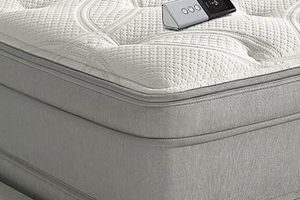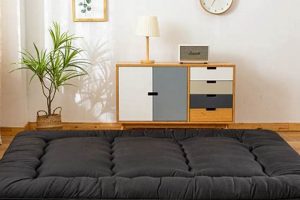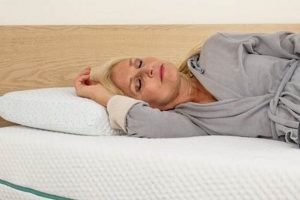Products featuring natural rubber offer a compliant and supportive sleep surface. These mattresses are often manufactured using the sap of rubber trees, processed to create a foam core. One common configuration features a design intended for ease of setup and long-term use.
The inherent elasticity of the material provides pressure relief, contouring to the body while maintaining spinal alignment. Its open-cell structure promotes breathability, contributing to temperature regulation during sleep. Historically, mattresses made with this material have been favored for their durability and resistance to dust mites and allergens. The resulting comfort can potentially enhance sleep quality.
This article will delve into the composition, construction, and care of mattresses of this type, along with a comparison of their characteristics relative to other mattress materials such as memory foam and innerspring coils. Furthermore, factors influencing purchase decisions, including firmness options and warranty considerations, will be explored.
Optimizing the Performance of a Latex Mattress
Proper maintenance and informed usage can maximize the lifespan and comfort of natural rubber mattresses. Adhering to these guidelines will contribute to a more satisfying sleep experience.
Tip 1: Use a Supportive Foundation: A solid or slatted foundation is essential to prevent sagging and ensure even weight distribution. Avoid foundations with excessive spacing between slats, as this can compromise support and void warranty provisions.
Tip 2: Employ a Mattress Protector: A waterproof and breathable mattress protector safeguards the surface from spills, stains, and dust mites. Select a protector specifically designed for latex mattresses to avoid hindering airflow.
Tip 3: Rotate Regularly: Rotate the mattress 180 degrees every three to six months to promote even wear. This is particularly important for single-sided models, extending the lifespan and preventing body impressions.
Tip 4: Avoid Direct Sunlight: Prolonged exposure to direct sunlight can degrade the latex material. Ensure the mattress is positioned away from direct sunlight or use window coverings to mitigate potential damage.
Tip 5: Clean Spills Immediately: Address spills promptly with a clean, damp cloth. Avoid using harsh chemicals or excessive moisture, which can damage the latex. Consult the manufacturer’s care instructions for specific cleaning recommendations.
Tip 6: Understand Firmness Levels: Select a firmness level that aligns with individual sleep preferences and body weight. Consider factors such as sleeping position (side, back, or stomach) when determining the optimal firmness for optimal spinal alignment.
Tip 7: Ventilate Regularly: Ensure adequate ventilation around the mattress to prevent moisture buildup. Periodically remove bedding and allow the mattress to air out for a few hours, particularly in humid environments.
By implementing these preventative measures and maintenance practices, the durability and comfort of the mattress can be significantly enhanced, contributing to improved sleep quality and overall well-being.
The following section will present a comparative analysis of various latex mattress options, highlighting key features and price points to assist in informed decision-making.
1. Material Composition
Material composition is foundational to the performance and suitability of any latex mattress. It directly influences comfort, support, durability, and overall user experience. Understanding the components and their interactions is essential for discerning the quality and characteristics of a mattress.
- Natural Latex Source
The source of the latex, typically the rubber tree (Hevea brasiliensis), dictates its inherent properties. Natural latex offers resilience, elasticity, and breathability. The absence of synthetic fillers or additives contributes to the mattress’s hypoallergenic qualities and overall durability.
- Dunlop vs. Talalay Processing
Two primary processing methodsDunlop and Talalayresult in different latex foam densities and textures. Dunlop yields a denser, firmer core, often found in the base layers of a mattress. Talalay produces a softer, more uniform consistency, frequently used in comfort layers for enhanced pressure relief.
- Blending with Synthetic Latex
Some mattresses incorporate synthetic latex, derived from petrochemicals, to reduce cost or alter specific performance characteristics. While synthetic latex can enhance durability, it may compromise breathability and overall comfort compared to pure natural latex. The proportion of synthetic to natural latex significantly impacts the mattress’s properties.
- Fabric Cover Material
The composition of the mattress cover also contributes to the overall experience. Organic cotton or bamboo-derived rayon covers are commonly used for their breathability and moisture-wicking properties. The weave and thickness of the cover can influence airflow and surface feel.
The interplay of these componentsnatural latex source, processing method, potential blending with synthetic materials, and cover fabricdefines the qualities of a mattress. A fully natural, properly processed product will provide a distinct balance of comfort, support, and durability compared to those incorporating synthetic elements or utilizing less rigorous manufacturing techniques. Thorough consideration of these factors is essential for making an informed purchase decision.
2. Firmness Options
The selection of appropriate firmness represents a critical determinant in user satisfaction with any mattress, including latex models. Firmness, in the context of a sleep surface, denotes the degree of resistance encountered when pressure is applied. Variations in firmness arise from differences in core density, layering configurations, and, in some cases, the incorporation of comfort layers constructed from alternative materials. For example, a mattress intended for back sleepers may benefit from a firmer core to maintain spinal alignment, whereas side sleepers often require a softer surface to alleviate pressure on shoulders and hips. The Sleep EZ latex mattress line offers a range of firmness options designed to accommodate diverse sleep preferences and body types.
The interaction between mattress firmness and individual body weight also plays a significant role in optimizing sleep quality. Individuals with higher body mass typically require firmer mattresses to prevent excessive sinking and maintain adequate support. Conversely, lighter individuals may find overly firm mattresses uncomfortable, as they may not experience sufficient contouring and pressure relief. Reputable latex mattress manufacturers provide detailed guidance regarding firmness selection based on body weight and preferred sleep position. Failing to consider these factors can lead to discomfort, disrupted sleep, and potential musculoskeletal issues.
In summary, firmness options are integral to the overall performance and suitability of a Sleep EZ latex mattress. Careful consideration of sleep position, body weight, and personal preferences is essential to selecting the appropriate firmness level. This informed decision-making process is crucial for maximizing comfort, promoting proper spinal alignment, and ultimately enhancing sleep quality. The availability of diverse firmness options underscores the importance of individual customization in achieving an optimal sleep experience.
3. Construction Methods
The construction methods employed in creating a Sleep EZ latex mattress exert a direct influence on its overall performance, durability, and feel. These methods encompass the layering of latex foam, the types of seams used to join components, and the integration of any additional materials, such as comfort layers or support cores. For instance, a mattress utilizing a multi-layered construction, featuring varying densities of latex, can provide a more customized level of support compared to a single-layer design. The type of adhesive used to bond layers is also critical; water-based adhesives, for example, are preferred due to their lower emission of volatile organic compounds (VOCs).
Furthermore, the method of quilting the mattress cover to the latex core significantly impacts surface comfort and airflow. A loosely quilted cover allows for greater breathability, which can contribute to temperature regulation during sleep. Conversely, a tightly quilted cover may enhance surface firmness but potentially restrict airflow. The design of the edge support system, if present, also influences the usable sleep surface and the mattress’s resistance to sagging over time. Mattresses with reinforced edges tend to offer greater stability and prevent the “roll-off” sensation.
In conclusion, construction methods are not merely aesthetic details but rather fundamental determinants of a Sleep EZ latex mattress’s functional characteristics. The choices made in layering, adhesives, quilting, and edge support contribute directly to the mattress’s ability to provide appropriate support, pressure relief, and long-term durability. Understanding these construction details allows consumers to make more informed purchasing decisions and select a mattress tailored to their specific needs and preferences, while prioritizing quality and environmentally conscious manufacturing practices.
4. Certifications Standards
Certifications standards applicable to components are crucial for verifying health, safety, and environmental claims associated with a Sleep EZ latex mattress. These standards provide assurance that materials meet specific criteria related to chemical emissions, material composition, and manufacturing processes, independent of manufacturer assertions. Their presence lends credibility and transparency to the product’s marketing claims.
- OEKO-TEX Standard 100
This certification verifies that every component of the mattress (fabric, threads, latex foam) has been tested for harmful substances and is harmless to human health. It limits the use of potentially harmful chemicals such as formaldehyde, pesticides, and heavy metals. For a Sleep EZ latex mattress, OEKO-TEX certification indicates that even in direct and prolonged contact with skin, the product poses minimal risk of adverse health effects.
- Global Organic Latex Standard (GOLS)
GOLS certification specifically addresses the natural latex foam used in the mattress. It ensures that the latex is produced from organically grown rubber trees, that the processing adheres to strict environmental and social criteria, and that the final product contains a minimum percentage of certified organic latex. This certification assures consumers that the Sleep EZ latex mattress supports sustainable agricultural practices and minimizes environmental impact.
- eco-INSTITUT
This standard focuses on low emissions of volatile organic compounds (VOCs) from the entire mattress. It tests for a wide range of VOCs and sets stringent limits to ensure indoor air quality is not compromised. A Sleep EZ latex mattress with eco-INSTITUT certification indicates a reduced risk of off-gassing and potential respiratory irritation, contributing to a healthier sleep environment.
- CertiPUR-US
While not specific to natural latex, CertiPUR-US certification applies to any polyurethane foam used in the mattress, such as comfort layers or support components. It verifies that the foam is made without ozone depleters, certain flame retardants, heavy metals, formaldehyde, and phthalates regulated by the Consumer Product Safety Commission. This certification ensures that any non-latex foam components within a Sleep EZ latex mattress meet established safety standards.
The presence of these certifications, either individually or in combination, provides consumers with a tangible means of assessing the quality and safety of a Sleep EZ latex mattress. Independent verification through these standards enables informed purchasing decisions and supports manufacturers committed to transparency and responsible production practices.
5. Longevity Estimates
The anticipated lifespan represents a key determinant in the economic value proposition. Projected durability is directly correlated with material composition, construction methodology, and the degree of ongoing maintenance applied to the sleep surface. An extended usage period amortizes the initial purchase cost, increasing the value derived from such product.
- Latex Density and Composition
The density of the latex core and the ratio of natural to synthetic latex significantly impact its degradation rate. Higher density natural latex is more resistant to compression and breakdown, leading to extended lifespan. Synthetic additives, while potentially improving certain performance characteristics, can reduce overall durability. The quality of raw materials directly correlates with the long-term structural integrity of the mattress core.
- Support Foundation and Usage Patterns
The type of foundation used beneath the mattress plays a crucial role in preventing premature sagging. A solid or closely-slatted foundation provides adequate support, distributing weight evenly. Irregular usage patterns, such as concentrating weight in a specific area, can accelerate wear and tear. Rotating the mattress regularly mitigates localized compression and extends its usable lifespan. Adherence to recommended weight limits is also essential for preserving structural integrity.
- Environmental Factors and Maintenance
Exposure to environmental factors, such as direct sunlight or excessive humidity, can degrade latex over time. Sunlight promotes oxidation, leading to material embrittlement. Humidity fosters mold and mildew growth, compromising the structural integrity of the mattress core. Regular cleaning and the use of a mattress protector can mitigate the negative effects of these environmental factors, preserving the mattress’s durability.
- Warranty Provisions and Manufacturer Reputation
The length and scope of the manufacturer’s warranty provide insight into their confidence in the product’s longevity. Reputable manufacturers often offer extended warranties on latex mattresses due to the inherent durability of the material. Scrutinizing warranty terms and researching the manufacturer’s reputation for honoring claims is essential. A comprehensive warranty offers a degree of protection against premature failure due to manufacturing defects.
These factors are crucial elements in gauging the longevity and overall value of a Sleep EZ latex mattress, as these details ensures a long-lasting return on investment. Understanding the interplay between material composition, usage patterns, environmental influences, and manufacturer warranties enables informed purchasing decisions. Prioritizing high-density natural latex, proper support structures, preventative maintenance, and reputable manufacturers contributes to maximizing the lifespan and minimizing long-term costs.
6. Temperature Regulation
Temperature regulation significantly impacts sleep quality, representing a key feature in mattress design. Elevated body temperature can disrupt sleep cycles, leading to restlessness and reduced restorative sleep. Mattress materials and construction directly influence heat retention and airflow, thereby affecting the sleeping environment. Products crafted from natural latex are noted for their breathability, contributing to improved temperature regulation. This characteristic stems from the open-cell structure inherent in latex foam, which facilitates air circulation and minimizes heat buildup. In contrast, materials such as memory foam, while offering conforming support, tend to trap heat due to their denser structure. This difference in breathability can affect overall comfort levels.
The construction further augments temperature regulation. The layering of components, such as a breathable cover material (e.g., organic cotton or bamboo), can enhance airflow and wick away moisture. Examples include mattresses employing perforated latex layers or incorporating cooling gel infusions to dissipate heat. Conversely, densely packed layers or impermeable covers can impede airflow, leading to a warmer sleep environment. The Sleep EZ latex mattress, characterized by its material composition and construction, emphasizes breathability to mitigate overheating and promote a more comfortable sleep climate.
In summary, temperature regulation represents a pivotal consideration in mattress selection. The open-cell structure, coupled with design choices aimed at enhancing airflow, can contribute to a cooler and more restful sleep experience. This is particularly important for individuals who tend to sleep hot or reside in warmer climates. Effective heat management promotes stability, thus highlighting the importance of informed material and design selection in achieving optimal sleep conditions.
Frequently Asked Questions about Latex Mattresses
This section addresses common inquiries concerning latex mattresses. The objective is to provide clear, factual information to assist in informed decision-making.
Question 1: What is the expected lifespan of a latex mattress?
The longevity of a latex mattress is contingent upon several factors, including latex density, manufacturing processes, and maintenance practices. High-quality natural latex mattresses can typically maintain their structural integrity for 10 to 15 years, or even longer with proper care. Synthetic or blended latex mattresses generally exhibit a shorter lifespan. Regular rotation and the use of a supportive foundation can optimize product longevity.
Question 2: Are latex mattresses suitable for individuals with allergies?
Natural latex inherently possesses hypoallergenic properties and resistance to dust mites. However, individuals with known latex allergies should exercise caution and consider alternative mattress materials. While processing removes the majority of allergenic proteins, trace amounts may remain. Certified organic latex mattresses, processed using specific techniques, may further reduce the risk of allergic reactions. A thorough assessment of personal sensitivities is advisable.
Question 3: How does the firmness of a latex mattress impact sleep quality?
Mattress firmness directly affects spinal alignment and pressure distribution. Individuals should select firmness levels appropriate for their preferred sleep position and body weight. Side sleepers often benefit from softer mattresses to alleviate pressure on the shoulders and hips, while back and stomach sleepers typically require firmer surfaces to maintain spinal alignment. Objective evaluation of firmness levels is recommended to ensure optimal sleep quality.
Question 4: What are the differences between Dunlop and Talalay latex?
Dunlop and Talalay are distinct processing methods that yield latex foam with differing characteristics. Dunlop latex is denser and firmer, often used in the support core of mattresses. Talalay latex is less dense and softer, typically found in comfort layers. Dunlop latex is generally considered more durable, while Talalay latex offers enhanced pressure relief. The selection between the two depends on individual preferences and intended use.
Question 5: Do latex mattresses require specialized care?
Maintaining a latex mattress involves relatively simple practices. Regular rotation, typically every three to six months, promotes even wear. Spot cleaning spills with a mild detergent and water is recommended. Avoid using harsh chemicals or excessive moisture, which can damage the latex. The use of a mattress protector safeguards against stains and allergens. Adherence to these guidelines contributes to prolonged product lifespan.
Question 6: What factors influence the price of a latex mattress?
The price of a latex mattress is determined by several factors, including latex purity (natural versus synthetic), density, manufacturing processes, certifications, and brand reputation. Mattresses made from 100% natural latex, processed using sustainable methods, and bearing recognized certifications command higher prices. Understanding these factors enables consumers to assess the value proposition of different products.
These frequently asked questions have clarified several important aspects. These mattresses offer benefits such as great comfort, and durability.
The following section will examine the environmental impact of producing this product.
Sleep EZ Latex Mattress
The preceding analysis has explored the composition, construction, maintenance, and certifications pertinent to this type of mattress. Key considerations include the source and processing of the latex, available firmness options, internal construction techniques, adherence to industry safety standards, and projected product longevity. Understanding these variables equips prospective purchasers with the necessary framework for evaluating product claims and aligning purchase decisions with individual needs.
Selection requires a meticulous evaluation of individual preferences, budgetary constraints, and a commitment to informed consumerism. Further independent research and critical analysis of manufacturer specifications are encouraged to optimize the value proposition and ensure long-term satisfaction.







![Top-Rated Best Sleeping Mattress for Camping: [Year] Guide Organic & Natural Mattress Buyer’s Guide: Non-Toxic Sleep Solutions Top-Rated Best Sleeping Mattress for Camping: [Year] Guide | Organic & Natural Mattress Buyer’s Guide: Non-Toxic Sleep Solutions](https://mattressworldpa.com/wp-content/uploads/2025/07/th-1737-300x200.jpg)